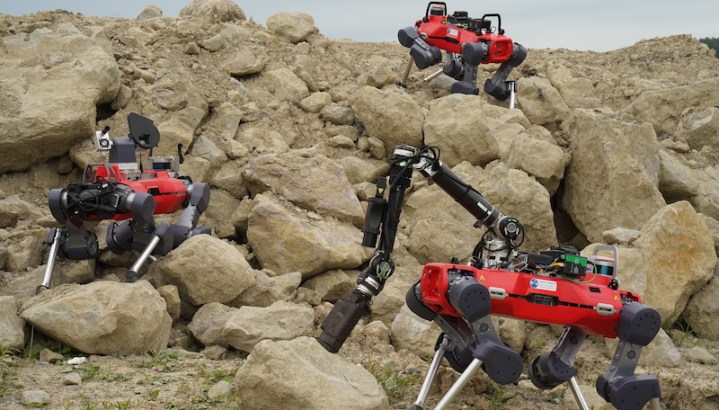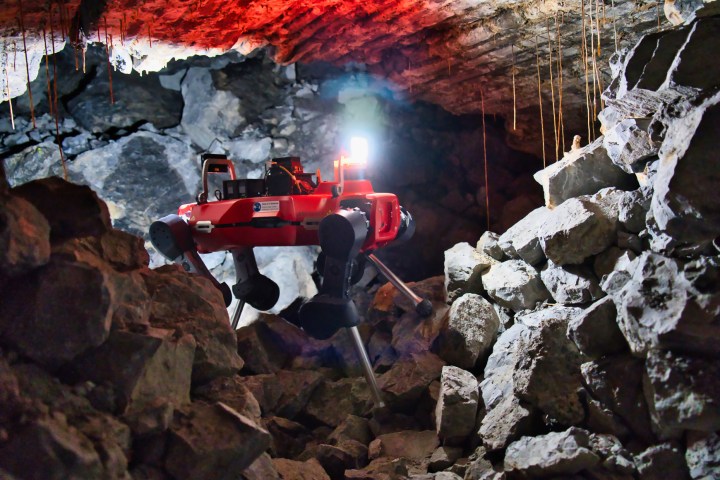
If you’d been a fly on the wall at the Rockhal concert hall in Luxembourg in September 2022, you’d have been greeted by a strange sight: no bands or cheering crowds in sight, but rather an area filled with 220 tons of lava and rock, with teams of robots crawling across the dusty floor in search of resources.
It was the second and final round of the European Space Agency (ESA)’s Space Resources Challenge, which invited research groups to bring their prototype robots and test out their abilities to prospect for resources in a simulated moon environment. The idea was to look for bright ideas for the next generation of robotic space explorers that could help locate and map lunar resources, such as water, which are essential for future crewed missions.
One of the winning teams of the challenge was a trio of legged robots that trotted, clambered, and poked their way around the arena, working together to map, identify, and collect scientific samples. Though this challenge was focused on the moon, the same principles could be applied to robots destined for Mars and other planetary bodies — and this approach could allow robots to explore new environments that have never been seen before.
We spoke to Hendrik Kolvenbach of the Robotic Systems Lab at ETH Zurich, the group that created the legged robots, to learn more.
An idea with legs
The aspiring moon bots aren’t built from scratch; they start as commercially available robots from ANYbotics, which creates legged robots similar to those from Boston Dynamics. These models are mostly used for industrial inspections, but they could have potential for off-world exploration as well.

The Robotic Systems Lab has customized these robots’ hardware and software, including byadding a robotic arm for grabbing rocks off the martian surface and trying out different gait patterns to cope with changing terrain. About the size of a medium dog, the version of the robots used in the ESA challenge were able to carry a small payload of up to 33 pounds, but Kolvenbach said that newer systems are able to carry up to 110 pounds.
That’s enough for a legged robot to carry scientific instruments like cameras, spectrographs, or even a small drill. The robots are trained using reinforcement learning, so they learn to move around difficult environments using simulations. They can even learn to use three of their legs to stand while they use their fourth limb to prod and manipulate objects in their environment.
The eventual goal of such research is to create modular hardware systems. Instead of space explorers having to be built from scratch for every mission, future missions could take advantage of developing robotics technology here on Earth that uses a base configuration that can be adapted with different instruments and software as required.
Kolvenbach compared it to the idea of CubeSats, a standardized interface and form factor that allows incorporation of different payloads, making development for space cheaper and making hardware reusable.
Exploring the unknown
Wheeled robots like the Curiosity and Perseverance rovers currently exploring Mars are great for some things. They travel relatively fast across wide open terrain, and they are able to handle going around, or over, surprisingly large rocks and other obstacles. Even when their wheels inevitably sustain damage from years of schlepping across the martian surface, as happened to Curiosity, they can still keep going as long as the drivers are careful.
So why would legged robots be necessary? It all depends on the environments that missions want to explore. Both Mars and the moon have surfaces covered in dusty material called regolith, for example, which rovers are designed to traverse.
But both locations also have intriguing underground regions such as lava tubes, which are cave-like structures beneath the surface created by the long-ago passage of hot lava.

These lava tubes are of great scientific interest, and there’s also a practical interest in using them as shelter for future crewed missions as astronauts could set up underground bases in them and be protected from dangerous radiation on the surface. But no one knows exactly what these environments are like, so any robot hoping to explore them would have to be versatile and able to handle unexpected challenges.
Legged robots are ideal for this kind of environment. They’re also well suited to dealing with steep slopes, like those found in craters. That’s handy for areas like the south pole of the moon, a current hotspot of exploration activity that hosts craters that are permanently shadowed, and which could host vital water ice resources.
Slopes can be tricky. “With wheeled robots, we always have a traction issue,” Kolvenbach explained. “The regolith is dry, granular material and you have a lot of cases where rovers get stuck.”
Legged robots are “generally more mobile, but it comes at a cost.” For flat areas without big challenges, wheeled robots are more efficient and there’s no need for more complex legged robots. For getting a broad overview of a large region, there’s the option of surveying from the air, as demonstrated by the Mars Ingenuity helicopter. But when it comes to unpredictable and unstructured terrain, legged robots are “very agile and robust,” Kolvenbach said. “This is where the unique value of these robots lie.”
Working as a team
Another way to approach the challenges of robotic exploration is to consider the possibilities of teamwork. With each legged robot being much smaller than a current Mars rover, several of them would be needed to carry the same payload as a single wheeled robot. But that can be an advantage, as the robots can work individually and as a team.
For the ESA challenge, the lab used a team of three legged robots, though a team could theoretically be larger or smaller as required by a mission. By changing how the different payloads are distributed among team members, you can create robot specialists. For example, one robot could carry tools for quickly mapping a large area, while another carries scientific instruments for investigating particular points of interest in detail.
The trend now goes to these more challenging environments, because there you can do very interesting science.
This also brings the benefits of redundancy, as the most vital functions can be shared across team members. So if one robot fails for any reason, the others can still keep operating and take over the majority of the failed robot’s tasks.
As for how a team of robots could communicate with each other, there are several approaches being considered in the robotics community. One is to have a central base that would coordinate the actions of each robot. That would be ideal for exploring large, open areas, as robots could be sent off in different directions to perform tasks like collecting samples, which could then be brought back to the base for analysis. Larger and heavier instruments could remain in the central base unit, with robots acting as couriers.
Another approach is to use communication nodes, with robots acting as relays for sending commands. That would be ideal for exploring underground regions where communications might be limited. Robots could drop a breadcrumb-like trail of sensors to relay commands, allowing them to communicate even in unknown environments.
The real benefit of this approach is flexibility. What payloads each robot carries, how many robots are part of a team, and how that team is structured is all adjustable based on the needs of a particular mission or environment.
Getting to space
The legged robots the researchers have been working with are commercial hardware, so while they show the promise of the technology for space exploration, they’re a long way from being space-worthy. Putting hardware on a space mission has stringent requirements, from the ability to withstand a wide range of temperatures, to handling the vibrations and shocks of launch, to a need for extremely high reliability, as there are no repair shops outside Earth.
So in preparation, the team is working on a spaceflight-ready legged robot called Space Hopper. “It’s a relatively small-scale robot,” Kolvenbach said. It weighs less than 22 pounds, and it uses off-the-shelf spaceflight hardware. It was a pragmatic first step because “the transfer from a research prototype to an actual space probe is a lot of engineering work. So we decided to make something small scale.”
They are hoping that Hopper will be ready to fly as a technology demonstration within the next few years, just in time for the ramping up of space agency and commercial missions to the moon. Hopefully, it will open the door for further development of larger and more complex legged robots for exploring new environments.
Kolvenbach describes the future use of legged robots as a “no brainer.” There are many cases where a wheeled robot still makes sense for planetary exploration, but when it comes to exploring more challenging and scientifically interesting environments, he sees legged robots as the future.
“There’s a clear need for this,” he said. “We’ve done a lot of missions in the past to relatively flat, easy environments on other celestial bodies. But the trend now goes to these more challenging environments, because there you can do very interesting science. From the scientific community, there’s clearly a requirement to go there. And legged robots are one of the emerging technologies that can bring us there to do that science.”



